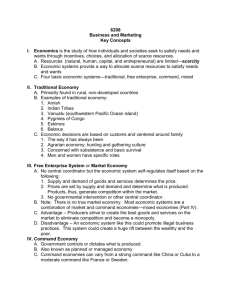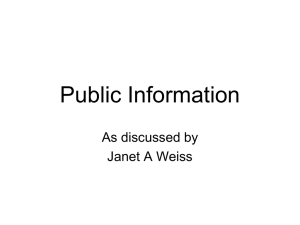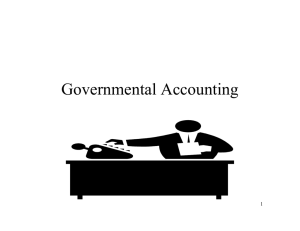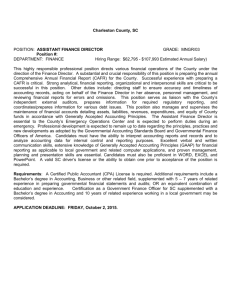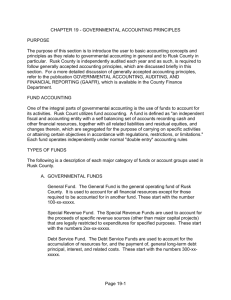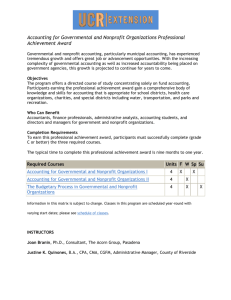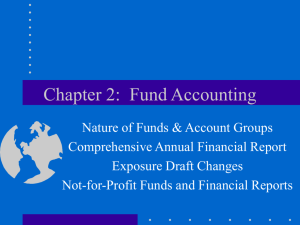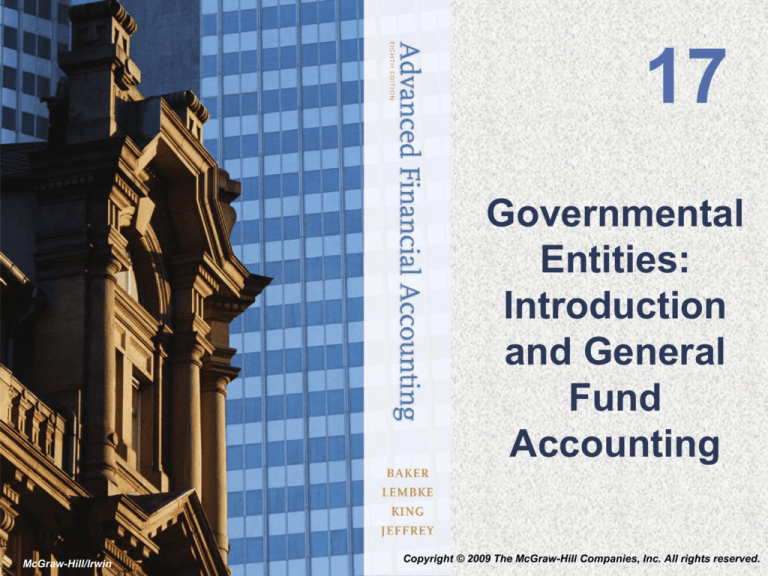
17
Governmental
Entities:
Introduction
and General
Fund
Accounting
McGraw-Hill/Irwin
Copyright © 2009 The McGraw-Hill Companies, Inc. All rights reserved.
Overview
•
Governmental entities have operating
objectives different from those of
commercial entities; therefore,
governmental accounting is different from
accounting for commercial enterprises
17-2
Overview
•
Nature of governmental entities:
1. Collect resources and make expenditures to
fulfill societal needs
2. Absence of profit motive except for some
activities
3. Have legal authorization for their existence,
conduct revenue-raising through the power of
taxation, and have mandated expenditures
they must make to provide their services
17-3
Overview
•
Nature of governmental entities:
4. Control mechanism - Use of comprehensive
budgetary accounting
5. Accountability for the flow of financial
resources is a chief objective
6. Typically are required to establish separate
funds to carry out various missions; each fund
is an independent accounting and fiscal entity
17-4
Overview
•
Nature of governmental entities:
7. Many fund entities do not record fixed assets
or long-term debt in their funds
8. An important objective of governmental
financial reporting is accountability
17-5
History of Governmental Accounting
•
History
– Before 1984, directed by the Municipal
Finance Officers Association (MFOA)
– In 1934, the first statement on local
governmental accounting published
– In 1968, Governmental Accounting, Auditing,
and Financial Reporting (GAAFR) was
published
•
The GAAFR is periodically updated to include the
most recent governmental reporting standards
17-6
History of Governmental Accounting
– 1974 –The American Institute of Certified
Public Accountants (AICPA) published an
industry audit guide, in which it stated that
“except as modified in this guide, they
[GAAFR] constitute generally accepted
accounting principles”
– March 1979 – The National Council on
Governmental Accounting (NCGA) issued its
Statement No. 1, “Governmental Accounting
and Financial Reporting Principles” (NCGA 1)
17-7
History of Governmental Accounting
•
1984 – Governmental Accounting
Standards Board (GASB) established
– GASB Statement No. 1
•
The GASB stated that all NCGA statements and
interpretations issued and in effect on that date
were accepted as generally accepted accounting
principles for governmental accounting
– GASB Statement 34
•
Established government-wide financial
statements to be prepared on the accrual basis
of accounting and an array of fund-based
financial statements
17-8
History of Governmental Accounting
•
•
The GASB continues to issue new
standards to meet the information needs of
users of the financial reports of
governmental units
Accounting for governmental entities is
given the general name of fund accounting
17-9
Major Concepts of Governmental
Accounting
•
Elements of financial statements
– Each definition uses the central focus of a
resource, which is an item having a present
capacity to provide, directly or indirectly,
services for the governmental entity
17-10
Major Concepts of Governmental
Accounting
•
Elements of a statement of financial condition:
1. Assets are resources with present service capacity
that the entity presently controls
2. Liabilities are present obligations to sacrifice
resources that the entity has little or no discretion to
avoid
3. A deferred outflow of resources is a consumption of
net assets that is applicable to a future reporting
period
4. A deferred inflow of resources is an acquisition of net
assets that is applicable to a future reporting period
5. Net position is the residual of all other elements
presented in a statement of financial condition
17-11
Major Concepts of Governmental
Accounting
•
Elements of the resource flows statements:
1. An outflow of resources is a consumption of
net assets that is applicable to the current
reporting period
2. An inflow of resources is an acquisition of net
assets that is applicable to the current
reporting period
17-12
Major Concepts of Governmental
Accounting
•
Expendability of resources versus capital
maintenance objectives
Commercial Enterprises
Measurement focus
The flow of all economic resources
Government Entities
Changes in current financial
resources available to provide
services to the public in
accordance with the budget
Method of Accounting
Accrual method
Modified accrual method
Balance sheet
Contains both current and
noncurrent assets and liabilities, and
the change in retained earnings
Reports only current assets,
reflects the company’s ability to
current liabilities, and a fund
maintain its capital investment
balance
17-13
Major Concepts of Governmental
Accounting
•
Definitions and types of funds
– To accomplish the objectives of the
governmental unit, the unit establishes a
variety of funds as fiscal and accounting
entities of the governmental unit
– A fund is a separate accounting group with
accounts to record the transactions and
prepare the financial statements of a defined
part of the governmental entity that is
responsible for specific activities or objectives
17-14
Major Concepts of Governmental
Accounting
•
•
Each governmental fund has its own asset
and liability accounts and its own revenue
and expenditures accounts
The term expenditures refers to decreases
in net financial resources available under
the current financial resources
measurement focus
17-15
Major Concepts of Governmental
Accounting
•
Types of funds
– Governmental Funds:
•
•
Used to provide basic governmental services to
the public
Each entity creates only one general fund, but it
may create more than one of each of the other
types of funds
– Proprietary Funds
•
The objective is to recover the unit’s costs
through user charges
– Fiduciary Funds
17-16
Major Concepts of Governmental
Accounting
Governmental Fund Types
General fund
Special revenue fund
Capital projects fund
Accounts for all financial resources except for those
accounted for in another fund. Includes transactions for
general governmental services provided by the executive,
legislative, and judicial operations of the governmental
entity.
Accounts for the proceeds of specific revenue sources that
are restricted for specified purposes.
Accounts for financial resources for the acquisition or
construction of major capital facilities that benefit many
citizens, such as parks and municipal buildings.
Debt service fund
Permanent fund
Accounts for the accumulation of resources for, and the
payment of, general long-term debt principal and interest.
Accounts for resources that are restricted such that only
earnings, but not principal, may be used in support of
governmental programs that benefit the government or its
citizenry.
17-17
Major Concepts of Governmental
Accounting
Proprietary Fund Types
Enterprise fund
Internal service fund
Accounts for operations of governmental units that charge
for services provided to the general public.
Accounts for the financing of goods or services provided
by one department or agency to other departments or
agencies of the governmental unit. Services are offered
only to governmental agencies.
Fiduciary Fund Types and Similar Component Units
Pension (and other
employee benefit) trust
fund
Investment trust fund
Private-purpose trust
fund
Agency fund
Accounts for resources required to be held in trust for the
members and beneficiaries of pension plans, other postemployment benefit plans, or other EBPs.
Accounts for the external portion of investment pools
reported by the sponsoring government.
Accounts for all other trust arrangements under which the
fund’s resources are to be used to benefit specific
individuals, private organizations, or other governments.
Accounts for assets held by a governmental unit in an
agency capacity for employees or for other governmental
units.
17-18
Financial Reporting of Governmental
Entities
•
The financial statements of a governmental
entity are presented for the reporting entity:
– The primary government
– Component units
– Other organizations that have a significant
relationship with the primary government
•
GASB 34 reporting model
– Fund-based financial statements
– Government-wide financial statements
17-19
The Government Reporting Model
17-20
Financial Reporting of Governmental
Entities
•
Governmental funds – financial statements:
– Balance sheet
– Statement of revenues, expenditures and
changes in fund balance
•
The five governmental funds use the current
financial resources measurement focus
17-21
Financial Reporting of Governmental
Entities
17-22
Financial Reporting of Governmental
Entities
•
Statement of revenues, expenditures, and
changes in fund balance
– Often called the operating statement of the
governmental funds
17-23
Measurement Focus and Basis of
Accounting
•
The modified accrual basis is used in funds
that have a flow of current financial
resources measurement focus
– The five governmental funds have this focus
•
The accrual basis is used in funds that have
a flow of economic resources measurement
focus
– Proprietary funds and fiduciary funds have this
focus
•
The government-wide financial statements
are based on the accrual basis
17-24
Measurement Focus and Basis of
Accounting
•
Basis of accounting—governmental funds
– Revenue is recorded in the accounting period
in which it is both measurable and available to
finance expenditures made during the current
fiscal period
– Expenditures are recognized in the period in
which the liabilities are both measurable and
incurred and are payable out of current
financial resources
17-25
Measurement Focus and Basis of
Accounting
•
Recognition of revenue: How revenues are recognized
depends on the category:
1. Derived tax revenues, resulting from assessments on
exchange transactions
•
•
2.
The asset is recognized when the underlying transaction occurs
or resources are received, whichever comes first
Revenue recognition depends on the accounting basis used to
measure the transaction
Imposed nonexchange revenues, resulting from assessments
on nongovernmental entities, including individuals
•
•
The asset is recognized when the government has an
enforceable legal claim to the resources or the resources are
received, whichever comes first
Revenue recognition is made in the period when use of the
resources for current expenditures is first permitted or required, or
at the time the asset is recorded if no time restriction on the
fund’s use of the resources exists
17-26
Measurement Focus and Basis of
Accounting
2. Imposed nonexchange revenues, resulting
from assessments on nongovernmental
entities, including individuals
•
•
The asset is recognized when the government
has an enforceable legal claim to the resources
or the resources are received, whichever comes
first
Revenue recognition is made in the period when
use of the resources for current expenditures is
first permitted or required, or at the time the
asset is recorded if no time restriction on the
fund’s use of the resources exists
17-27
Measurement Focus and Basis of
Accounting
•
Recognition of revenue:
3. Government-mandated nonexchange
transactions, resulting from one governmental
unit’s provision of resources to a
governmental unit at another level and the
requirement that the recipient use the
resources for a specific purpose
4. Voluntary nonexchange transactions, resulting
from legislative or contractual agreements,
other than exchanges
17-28
Budgetary Aspects of Governmental
Operations
•
Budgets
– Used in governmental accounting to assist in
management control and to provide the legal
authority to levy taxes, collect revenue, and
make expenditures in accordance with the
budget
– Types of budgets:
•
•
Operating budgets
Capital budgets
17-29
Budgetary Aspects of Governmental
Operations
•
Recording the Operating Budget
Assume that at January 1, 20X1, the first day of the new fiscal period, the city
council of Barb City approves the operating budget for the general fund,
providing for $900,000 in revenue and $850,000 in expenditures. Approval of
the budget provides the legal authority to levy the local property taxes and to
appropriate resources for the expenditures. The entry made in the general
fund’s accounting records on this date is as follows:
17-30
Budgetary Aspects of Governmental
Operations
–
–
–
–
The ESTIMATED REVENUES CONTROL account is
an anticipatory asset
The APPROPRIATIONS CONTROL account is an
anticipatory liability
The excess of estimated revenues over anticipated
expenditures is the budget surplus and is recorded to
BUDGETARY FUND BALANCE—UNRESERVED
Some approved budgets have budget deficits in which
expected expenditures exceed anticipated revenue
•
These budgets are recorded with a debit to BUDGETARY
FUND BALANCE—UNRESERVED
17-31
Accounting for Expenditures
•
The Expenditure Process
–
Step 1. Appropriation
•
–
Step 2. Encumbrance
•
–
An encumbrance is a reservation of part of the budgetary
appropriation and is recognized at the time an order is
placed for goods or services
Step 3. Expenditure
•
–
The budget provides the appropriating authority to make
future expenditures
An expenditure and a corresponding liability are recorded
when the governmental entity receives the goods or
services ordered in step 2
Step 4. Disbursement
•
A disbursement is the payment of cash for expenditures
17-32
Accounting for Expenditures
•
Classification of expenditure transactions
and accounts
– Expenditures should be classified by fund,
character, function (or program),
organizational unit, activity, and principal
classes of objects
•
Outstanding encumbrances at the end of
the fiscal period:
– May be allowed to lapse
– May be carried over as nonlapsing spending
authority
17-33
17-34
Accounting for Expenditures
•
Expenditures for inventory
– Determining the method to account for the
expenditure of inventories:
•
•
Purchase method: Recognizes the entire
expenditure for inventory in the period the
supplies are acquired
Consumption method: Recognizes expenditures
for only the amount of inventory used in the
period
– The specific method to follow depends on the
governing unit’s policy and how inventory
expenditures are included in the budget
17-35
Accounting for Expenditures
•
Expenditures for inventory
– Immaterial inventories need not be shown on
the balance sheet
– If the inventory is material, it is presented as
an asset on the balance sheet
•
An amount equal to the inventory also should be
shown as a reservation of the fund balance,
indicating that that amount is no longer
expendable
17-36
Accounting for Expenditures
17-37
Accounting for Expenditures
•
Accounting for fixed assets
– Governmental funds: Recognized as an
expenditure in the year the asset is acquired
– Proprietary funds: Account for acquisitions of
capital assets in the same manner as
commercial entities
•
Works of art and historical treasures
– For the purposes of government-wide financial
statements, governments should capitalize
these assets at their historical costs at
acquisition or at their fair values at the date of
the contribution
17-38
Accounting for Expenditures
•
Long-term debt and capital leases
– The governmental funds record the proceeds
from a bond issue as a debit to Cash and a
credit to Bond Issue Proceeds, an otherfinancing source
– Bond issue proceeds are not revenue
because the bonds must be repaid
– Bonds are not reported on the governmental
funds’ balance sheets but only on the
government-wide financial statements
– Capital leases are accounted for in a manner
similar to long-term debt
17-39
Accounting for Expenditures
•
Investments
– GASB 31 established a general rule of fair
market valuation for investments held by a
government entity
– Changes in the fair value of investments
should be recognized as an element of
investment income in the operating statement
(or statement of activities) of each fund
– GASB 40 requires footnote disclosures of the
policies and the profiles of the government’s
investment portfolios
17-40
Interfund Activities
•
•
Interfund activities are resource flows
between fund entities
GASB 34 established four types of interfund
activities:
–
–
–
–
Interfund loans
Interfund services provided and used
Interfund transfers
Interfund reimbursements
17-41
Interfund Activities
17-42
Overview of Accounting and Financial
Reporting for the General Fund
17-43
Overview of Accounting and Financial
Reporting for the General Fund
17-44
Additional Considerations
•
In February 2008, the GASB published an
exposure draft (ED) of a proposed
statement entitled “Fund Balance Reporting
and Governmental Fund Type Definitions”
– The proposed statement applies only to the
five governmental fund types
17-45

